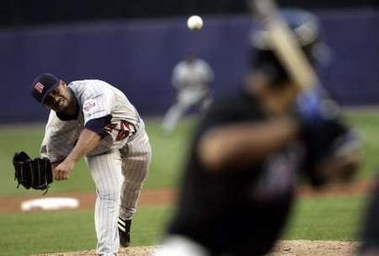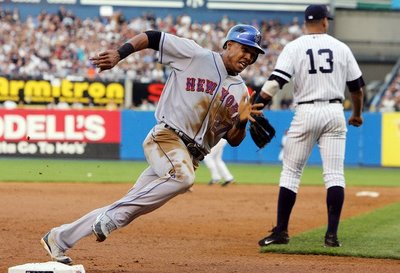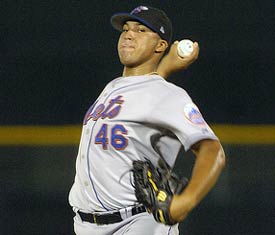January 30, 2008
So Long, Johan
We're just talkin' about the future
Forget about the past
It'll always be with us
It's never gonna die, never gonna die
The early days of this blog were filled with a "Free Johan Santana!" campaign that urged the Twins to move their young left-handed phenom into the starting rotation. After Santana spent the majority of four years in the bullpen and another half-season at Triple-A, the Twins finally gave him a permanent spot in the rotation to begin the 2004 season. He immediately became the best pitcher in baseball, winning the AL Cy Young by going 20-6 while leading the league with a 2.61 ERA and 265 strikeouts.- AC/DC, "Rock 'N Roll Ain't Noise Pollution"
In four seasons as a full-time starter Santana went 70-32 with a 2.89 ERA and 983 strikeouts in 912.1 innings, winning two ERA titles and three strikeout crowns while capturing a pair of Cy Young awards and deserving a third. It was an amazing metamorphosis. At 21 years old Santana was a little-known Rule 5 pick who showed some promise, at 23 years old he was an ace-in-waiting who dominated from the bullpen or rotation, and at 25 years old he was the best pitcher in baseball.
Now 28 years old, Santana has established himself as both one of the most successful pitchers in Twins history and one of the greatest left-handers of all time. Three weeks into this blog's existence there was an entry that began with this proclamation: "I suspect that many of you aren't very familiar with Mr. Santana, but with the way he's pitched this season that may change very quickly." And now, a little more than five years later, today's entry is about how the Twins traded Mr. Santana to the Mets.
 Santana and the Mets still need to work out a long-term contract extension before the trade becomes official, but assuming that happens the Twins will receive outfielder Carlos Gomez and right-handers Deolis Guerra, Kevin Mulvey, and Philip Humber. Baseball America's recent breakdown of the Mets' farm system ranked those four players as the team's No. 2, No. 3, No. 4, and No. 7 prospects, but the Twins unfortunately weren't able to get No. 1 prospect Fernando Martinez included in the deal.
Santana and the Mets still need to work out a long-term contract extension before the trade becomes official, but assuming that happens the Twins will receive outfielder Carlos Gomez and right-handers Deolis Guerra, Kevin Mulvey, and Philip Humber. Baseball America's recent breakdown of the Mets' farm system ranked those four players as the team's No. 2, No. 3, No. 4, and No. 7 prospects, but the Twins unfortunately weren't able to get No. 1 prospect Fernando Martinez included in the deal.
Trading the best pitcher in baseball without getting the Mets' top prospect in return is disappointing and without Martinez the package falls short of the deals that were rumored to have been offered from the Yankees and Red Sox. A month ago the Twins were said to be deciding between packages headed by Phil Hughes, Jacoby Ellsbury, and Jon Lester, and earlier this month they were reportedly pushing the Mets to include Martinez. Instead, they end up with none of those four players.
Either the oft-cited rumored offers involving Hughes, Ellsbury, and Lester were never actually on the table to begin with or general manager Bill Smith waited so long to pull the trigger that the Yankees and Red Sox eventually decided to take them off the table. All of which is what makes evaluating the package that the Twins ended up accepting somewhat tricky. On one hand, it seems fairly clear that the Twins would have been better off making Hughes or Ellsbury the centerpiece of a Santana trade.
Those two players possess the best combination of long-term upside and major-league readiness, so if at any point Smith passed on offers involving Hughes or Ellsbury then he made a big mistake and ultimately had to settle for something significantly less than the best possible package. On the other hand, when judged on its own and not compared to other offers that may or may not have been on the table, the Mets' package is a decent one.
It seems natural that a team should be able to have its pick of elite prospects when trading away baseball's premiere pitcher, but from the Twins' perspective all they were truly shopping was one season of Santana. While that's plenty valuable, getting four solid prospects for one season of any player seems reasonable. Of course, had the Twins kept Santana this season and simply let him walk as a free agent, they also would have gotten a pair of first-round draft picks as compensation.
Given that, what the Twins really gave up was one season of Santana and a pair of draft picks. That complicates things a bit, but four solid prospects still seems like a relatively palatable return given the added cost and uncertainty of draft picks. Still, my suspicion is that the Twins could have done better and perhaps cost themselves a chance to get the maximum return for Santana by attempting to squeeze extra value from teams.
In poker terms, Smith slow-played a big hand and ended up dragging in less than the maximum pot. It's hard to swallow the possibility that the Twins missed out on acquiring Hughes and Melky Cabrera or Ellsbury, Jed Lowrie, and Justin Masterson. Those were very good offers for Santana and without Martinez included the Mets' offer falls short of those standards. However, there's a difference between the Mets' offer not being the best one and the Mets' offer not being a decent one.
 Signed out of the Dominican Republic in 2002, Gomez has been rushed through the Mets' system and made his major-league debut as a 21-year-old last season despite logging just 36 games at Triple-A. He predictably struggled and there was little reason to push him so aggressively given his mediocre track record, suggesting that Gomez's development would benefit greatly from some additional time in the minors. Here are his combined numbers between Double-A and Triple-A:
Signed out of the Dominican Republic in 2002, Gomez has been rushed through the Mets' system and made his major-league debut as a 21-year-old last season despite logging just 36 games at Triple-A. He predictably struggled and there was little reason to push him so aggressively given his mediocre track record, suggesting that Gomez's development would benefit greatly from some additional time in the minors. Here are his combined numbers between Double-A and Triple-A:
G PA AVG OBP SLG HR XBH BB SO SB
156 643 .282 .354 .421 9 51 42 120 58
Gomez is already a strong defensive center fielder and an excellent base-stealer with game-changing speed, but his bat leaves a lot to be desired. He's often talked about as a five-tool player, but with just nine homers and a .139 Isolated Power in 643 plate appearances his power has been modest so far. Beyond that, his 120-to-42 strikeout-to-walk ratio shows poor plate discipline and sub par strike-zone control, both of which are concerns for someone who the Twins no doubt view as a leadoff man.
The Twins may be tempted to make Gomez their Opening Day center fielder, but he looks likely to be overmatched in the majors at this point and the team would be better off delaying his arrival by signing someone like Kenny Lofton or Corey Patterson to a one-year deal. Gomez has the talent to be an impact player in time, but he's yet to convert his tools into great on-field performance and is far from a sure thing to ever become an above-average regular, whereas Ellsbury is basically already there.
Even more so than Gomez, Guerra is the high-risk, high-upside part of the package. Signed out of Venezuela for $700,000 in 2005, he's another example of the Mets needlessly rushing their prospects, spending last season at high Single-A as an 18-year-old. Guerra held his own there, posting a 4.01 ERA and 66-to-25 strikeout-to-walk ratio in 89.2 innings, which is plenty impressive for a teenager who was facing much more experienced competition.
Guerra throws hard and at 6-foot-5 there's plenty of room to project even more velocity, but he missed time with a shoulder injury last season and has a long way to go before reaching the majors both in terms of time frame and development. Had he been with the Twins, it's possible that Guerra would have spent last season at rookie-ball. He has the highest ceiling among the four players acquired for Santana, but also carries by far the most risk.
 While Gomez and Guerra are all about projection and development, Mulvey and Humber are close to being MLB-ready and aren't especially far from reaching their relatively modest ceilings. Humber was a dominant pitcher in college, going 35-8 with a 2.80 ERA and 422 strikeouts in 353 innings at Rice University, and the Mets thought that they had a future ace when they took him with the No. 3 overall pick in the 2004 draft.
While Gomez and Guerra are all about projection and development, Mulvey and Humber are close to being MLB-ready and aren't especially far from reaching their relatively modest ceilings. Humber was a dominant pitcher in college, going 35-8 with a 2.80 ERA and 422 strikeouts in 353 innings at Rice University, and the Mets thought that they had a future ace when they took him with the No. 3 overall pick in the 2004 draft.
Humber's heavy college workload caught up to him just 15 starts into his pro career and he underwent Tommy John elbow surgery in 2005. He returned to the mound in the middle of the next season, but left some of his velocity on the operating table and hasn't been the same pitcher since. Once regarded as a potential No. 1 starter, Humber now looks like middle-of-the-rotation material after posting a 4.27 ERA and 120-to-44 strikeout-to-walk ratio in 139 innings at Triple-A as a 24-year-old.
Mulvey was a second-round pick out of Villanova in 2006 and reached Triple-A near the end of last season after posting a 3.02 ERA and 124-to-48 strikeout-to-walk ratio in 173 pro innings. While Humber is a fly-ball pitcher who has had problems keeping the ball in the ballpark post-surgery, Mulvey does a much better job inducing ground balls and has served up a total of just five homers in 173 innings. He also projects as a mid-rotation starter and should be ready by the All-Star break.
In a perfect world Santana would christen the new ballpark with an Opening Day start in 2010 and wear a Twins cap on his Hall of Fame plaque, but for whatever reason his remaining in Minnesota never seemed to be a legitimate option once the trade rumors began swirling. Swapping him for packages led by Hughes or Ellsbury would have put the Twins in a better position for both short- and long-term success, so if either of those deals were passed on then Smith made a major mistake.
With that said, getting Gomez, Guerra, Mulvey, and Humber from the Mets likely beats keeping Santana for one more season and taking a pair of draft picks when he departs as a free agent. A toolsy center fielder who hasn't shown much offensively, a very raw 18-year-old pitcher, and a pair of MLB-ready middle-of-the-rotation starters is no one's idea of a great haul for Santana, but it's not a horrible one and Smith may have backed himself into a corner by not jumping on better offers immediately.
The end result of a bad situation handled poorly is a mediocre package of players that has no one excited, but even acquiring Hughes or Ellsbury wouldn't have made losing Santana easy to live with. Trading away one of the best players in franchise history while he's still at the top of his game is a horrible thing and doing so without getting the best possible return for him is extremely disappointing, but the Santana trade still has a chance to work out in the Twins' favor. It just could have been better.

